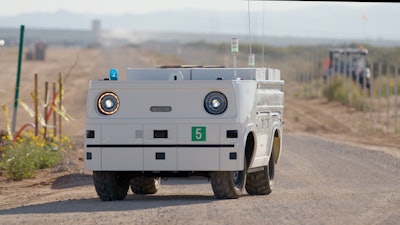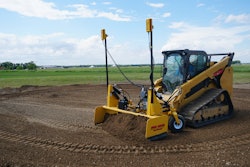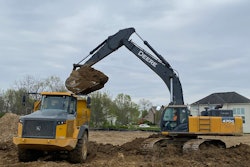
Every newbie who ever worked in construction knows the grunt work of having to haul material around the jobsite. Well, good news newbies.
Honda has a prototype robot that someday may put an end to this backbreaking tradition. At a large-scale Black & Veatch solar installation jobsite in New Mexico, the company successfully tested the latest prototype Honda Autonomous Work Vehicle (AWV). (Check out the video at the bottom of this story.)
And perhaps the coolest thing about the Honda AWV project is that it is actively soliciting contractors who want to help design the next version of the robot. Companies interested in testing the Honda AWV in their work environment can contact Honda at: [email protected].
Hefty payloads
During the month-long field test in New Mexico, the second-generation prototype of the fully electric Honda AWV performed a range of functions including towing activities and transporting construction materials, water and other supplies to pre-set destinations within the worksite.
The vehicle carried payloads of nearly 900 pounds, and in a separate use case, it towed a trailer hauling more than 1,600 pounds. While Honda previously tested an earlier generation of the Honda AWV, this field test was the first to deploy multiple units working collaboratively to support construction use cases.
Honda has been tinkering with the AWV platform for a while. It was introduced as a concept at the 2018 Consumer Electronics Show in Las Vegas. You can see what we wrote about the first version here: Honda unveils autonomous construction robot, wants your input on what to do with it
GPS guidance
The current version of the Honda AWV employs a suite of sensors to guide the unit autonomously, using GPS for location, radar and LiDAR for obstacle detection and stereoscopic (3D) cameras for remote monitoring. The vehicle also can be operated by remote control.
To validate the capabilities of the Honda AWV, the company selected a Black & Veatch’s solar energy construction site where support structures for solar panels are laid out in a grid pattern at regular intervals over a thousand acres. The site was an ideal environment to test the ability of the Honda AWV to stop at precise points along a pre-set route.
Cloud-based directions
Honda produced a high-definition map of the site that allowed Black & Veatch operators to precisely set start and stop points for multiple Honda AWVs using a cloud-based app interface that runs on tablets and PCs. The vehicles successfully delivered materials and supplies along a calculated route and stopped within centimeters of their pre-set points.
The field test also demonstrated the viability of the Honda AWV battery system to support energy-intensive sensors and provide vehicle propulsion, while operating up to eight hours in a high-temperature environment.
Based on the capabilities verified in this field test, Honda says its AWV will be capable of providing a wide range of services to a variety of industries that need a rugged off-road autonomous solution, especially where workforce constraints and safety concerns make other solutions impractical. The ability to operate autonomously, or with remote control, and carry large payloads, along with the potential to add attachments and tools, make the Honda AWV a suitable platform for many work environments.
Efficiency and safety
The goal of the project, according to Honda, is to create a rugged and durable off-road side-by-side platform with advanced autonomous technology capable of being deployed in a variety of dynamic work environments.
“We believe the Honda AWV has the potential to bring greater efficiencies, higher levels of safety and better environmental performance to the construction industry and to other industries seeking an autonomous off-road solution,” says Kenton Williams, project lead for the Honda AWV. Honda has not announced commercialization plans for the AWV yet, but is continuing to advance the platform through field testing.
You can watch a video below of the Honda AWV doing its thing:
Honda AWV Specs
- Dimensions: 9 feet 6 inches long; 8 inches high; 4 feet 11 inches wide
- Unladen weight: 1,590 pounds
- Max load capacity: 880 pounds
- Towing capability: 1,653 pounds (including trailer)
- Min. turning radius: 12 feet 9 inches
- Range: 27.9 miles depending on use case
- Charge time: Up to six hours











